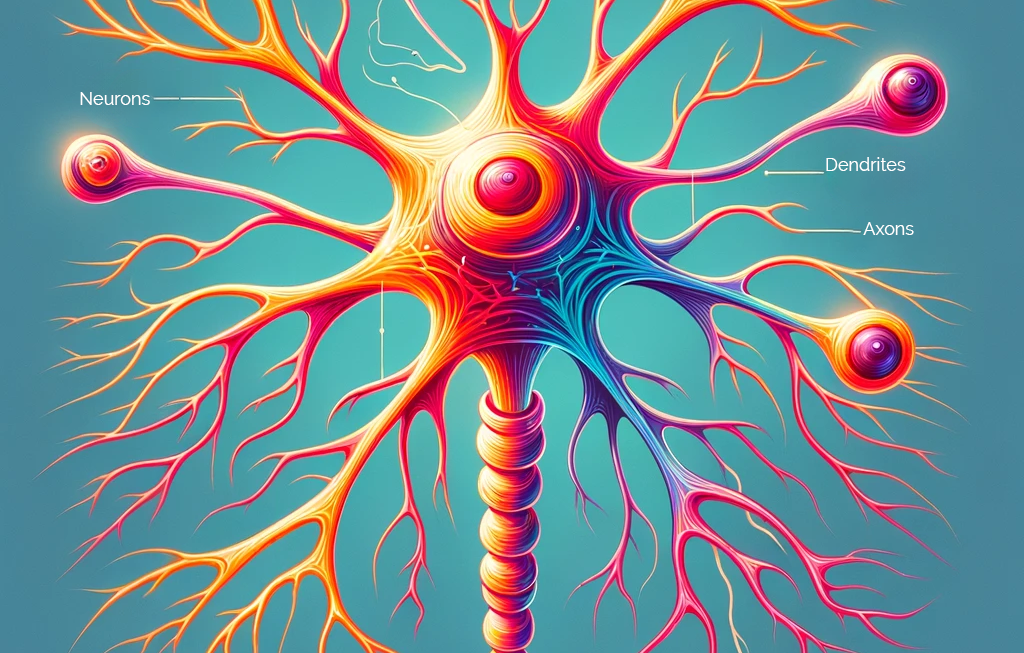Embark on a captivating exploration into the realm of the human brain, guided by the stars of this journey: neurons. This guide is meticulously designed for those stepping into the world of biopsychology for the first time or anyone intrigued by how we think, feel, and react. With no prerequisite knowledge needed, let’s delve into the wonders of our brain’s communication network.
Neuron Structure: The Brain’s Marvelous Messengers
The neuron is not just any cell; it’s the linchpin of our nervous system, the conductor of the symphony that is our thoughts, emotions, and movements. Let’s break down its components for a clearer picture:
- Cell Body (Soma): Picture the cell body as the neuron’s command center. It’s here in this central hub that crucial activities take place. Housing the nucleus, which contains the cell’s DNA, the cell body orchestrates the metabolic activities essential for the neuron’s survival and function. It’s akin to the engine room of a ship, keeping everything running smoothly.
- Dendrites: Imagine dendrites as the neuron’s sensory antennae. These branch-like extensions emanate from the cell body, each one reaching out to receive signals from other neurons. Dendrites are the listening ears, capturing messages through specialized junctions called synapses. The more dendrites a neuron has, the more information it can gather from its neighbors.
- Axons: Axons are the long, slender projections that carry electrical impulses away from the cell body to other neurons, muscles, or glands. Consider axons as the neuron’s transmission lines, spanning distances within the brain and throughout the body. Some axons are incredibly long, stretching from the brain all the way down to the toes, acting as the body’s communication superhighways.
Myelin Sheath: The Brain’s Speed Booster
Envision the myelin sheath as the insulation around an electrical wire. This fatty layer wraps around the axon in segments, with tiny gaps known as nodes of Ranvier between each segment. The myelin sheath is crucial for two reasons: it protects the axon and, more importantly, it enables nerve impulses to jump rapidly from node to node, significantly speeding up communication. This leapfrogging mechanism, called saltatory conduction, is why we can react to stimuli so quickly. Without myelin, our cognitive and physical responses would be markedly slower, akin to a computer running on an outdated processor.
The Magic of Nerve Impulses: The Language of the Brain
Nerve impulses, or action potentials, are the electrical signals that neurons use to communicate. These impulses are generated when a neuron receives a strong enough signal from another neuron. This change in electrical charge travels down the axon to the axon terminals, where it triggers the release of neurotransmitters into the synapse, thus conveying the message to the next neuron. This process is the cornerstone of all neuronal communication, enabling everything from the simplest reflex to the most complex thoughts.
Neurons and their ability to generate and transmit nerve impulses are the essence of our existence. They form the basis of our thoughts, feelings, actions, and interactions with the world around us. By understanding the basic principles of neuron structure and function, we can begin to appreciate the vast complexity and beauty of our brain’s inner workings.
FAQs
- What triggers a nerve impulse? A nerve impulse is triggered when a neuron receives enough stimulatory signals from other neurons, causing a rapid change in its electrical charge.
- Can neurons regenerate? Unlike many other cells, neurons in the adult human brain generally do not regenerate if damaged, though research into neuroplasticity and regeneration is ongoing.
- How fast can nerve impulses travel? Nerve impulse speed can vary widely, from as slow as 0.5 meters/second in some neurons to 120 meters/second in others, depending on the presence of a myelin sheath and the diameter of the axon.
Further Reading
- “Neuroscience: Exploring the Brain” by Mark F. Bear, Barry W. Connors, and Michael A. Paradiso
- “The Tale of the Dueling Neurosurgeons” by Sam Kean




